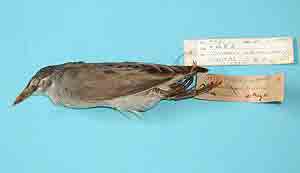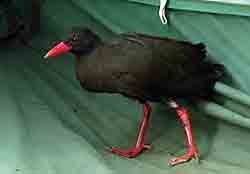- Home >
- OKinawa Rail >
- Rails and Extinction
The Okinawa Rail
Rails and Extinction
This page introduces how the species of rails that live on islands face greater risks of extinction and that there are many species in the world that are extinct or endangered. There is also an island rail species already extinct from Japan.
Island rails are more susceptible to extinction
Among the approximately 130 species of the rail family in the world, a significant number of them occur in islands far from the continents and some are endemic species or subspecies (species or subspecies only found on a specific island or chain of islands) and many of them are flightless.
These species of the rail family become extinct when a predator is introduced from outside of the island. The rails get captured easily and the population declines. The table below shows the status of extinction of island rails. The status of the island rails clearly shows how vulnerable island ecosystems are.
Extinction of White-browed Crake

White-browed Crake Poliolimnas cinereus is found widely from Southeast Asia to the Pacific islands. There used to be an endemic subspecies in the Iwo (Volcano) Islands of Japan. In 1889 P. A. Holst collected one individual in Iwo Island for the first time, and in 1911 a collector of A. Owston collected more individuals. There has not been solid evidence of existence since then, and thus this subspecies is currently considered extinct. The reason for this extinction is unknown, however, loss of wetlands and predation by cats are considered to be the main causes.
Calayan Rail Gallirallus calayanensis
 It was first discovered in the Calayan Islands of the northern Philippines and was described as a new species in August 2004. It is considered to be closely related to Okinawa Rail. [photograph provided by D. Allen]
It was first discovered in the Calayan Islands of the northern Philippines and was described as a new species in August 2004. It is considered to be closely related to Okinawa Rail. [photograph provided by D. Allen]

